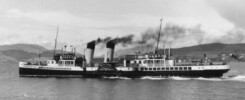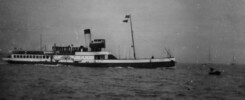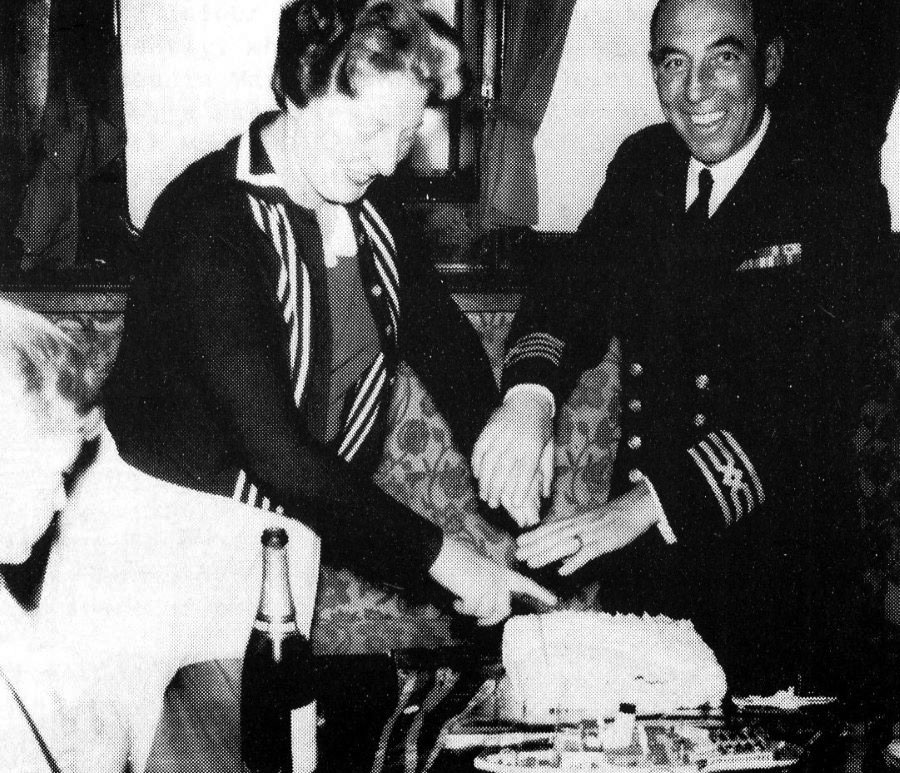
Captain Haines aboard Embassy cutting the cake with Mrs Mary Cox, wife of Bernard Cox one of the founding members of the PSPS, to celebrate the ship’s Golden Jubilee in 1961.
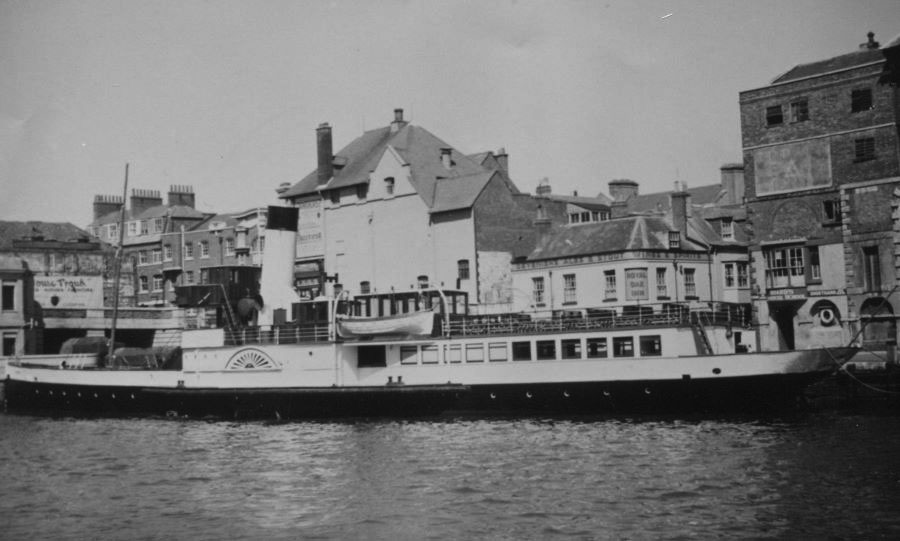
Captain Haines’s first command with Cosens was the freshly rebuilt Consul in 1949. Based at Weymouth she ran a combination of local cruises round Portland Harbour, to Portland Bill, the Shambles Lightship and Lulworth Cove as well as longer day trips to Swanage and Bournemouth. Sometimes she collected passengers from Bournemouth at Swanage and took them on to Lulworth Cove.
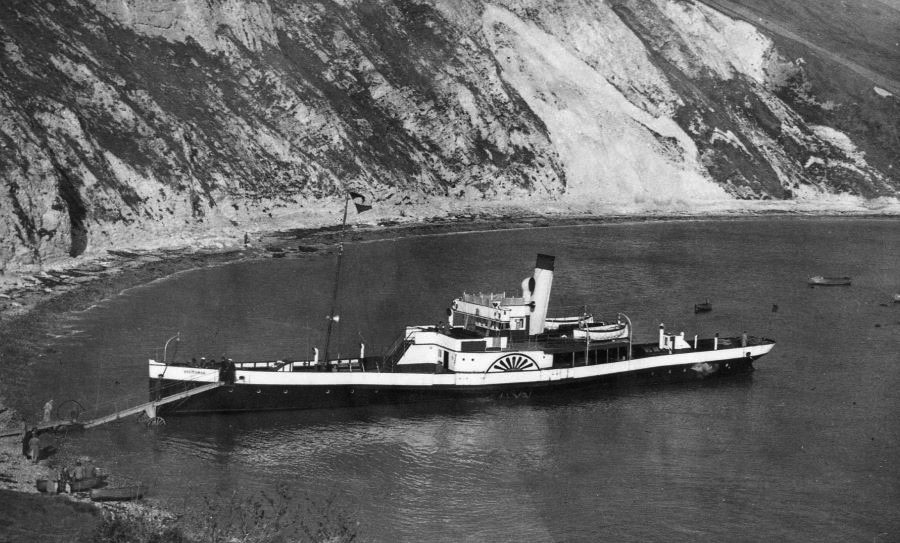
For the 1950 season Cosens had sold their veteran twin funnelled Monarch. Her master Captain Cooke therefore displaced Captain Haines on Consul and he was transferred to Victoria whose master Captain Holleyoak left the company.
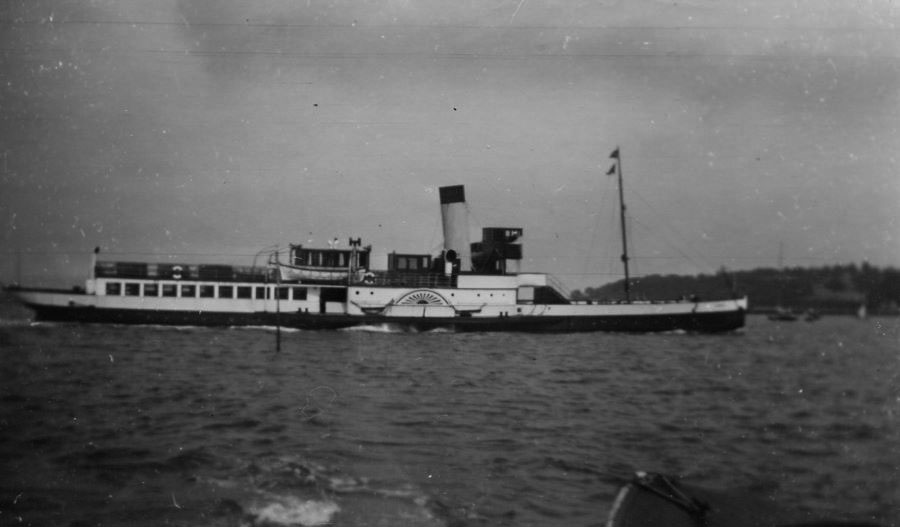
Captain Haines started the 1951 season once again on Victoria but transferred back onto Consul in June when Cosens bought the Portsmouth/Ryde ferry Shanklin and Captain Cooke left Consul to take over the new ship. This opened up an opportunity on Victoria which was filled by mate and occasional relief master Captain Harry Defrates.
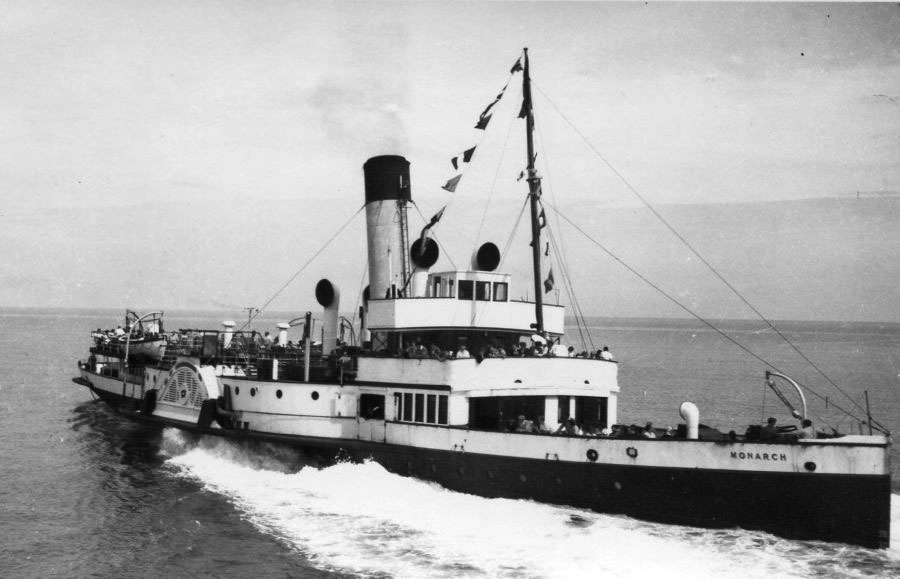
For 1952 there was a jiggle round of masters. The more senior Captain Moore decided that he would prefer to spend more nights at home so transferred to the Weymouth based Victoria. Her master Captain Defrates moved onto Consul. Captain Cooke took over Embassy from Captain Moore and Captain Haines therefore had the Monarch. On her he stayed for two seasons running mostly between Bournemouth and Swanage with occasional trips to the Isle of Wight most particularly around the start and finish of the seasons.
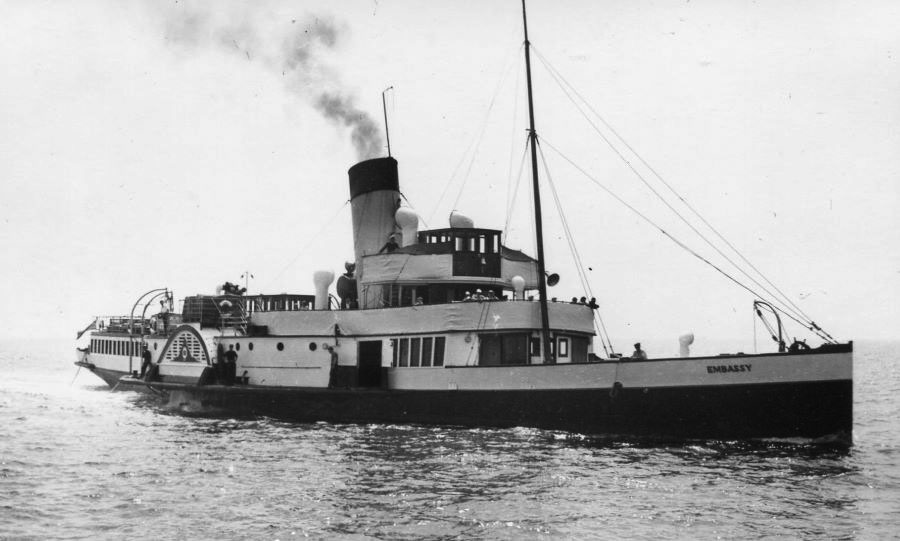
After the 1953 season Captain Cooke left Cosens to become a Poole Harbour pilot. It was a more secure sort of job. The money was better and so were the pension arrangements. Although Cosens very occasionally granted a personal pension to a handful of long serving employees they had no general pension provisions for their staff and crews.
With Captain Cooke having moved on and the more senior Captain Moore preferring to be Weymouth based, Captain Haines therefore took over Embassy. At that stage in her career she generally ran the longer day trips from Bournemouth being smaller and more economical on running costs as well as being more reliable than the flagship of the fleet Emperor of India. Based overnight at Poole, Embassy ran from Swanage and Bournemouth to Weymouth, Totland Bay, Yarmouth, Ryde, Cowes, Southampton and round the Isle of Wight as well as longer coastal cruises for example viewing Lulworth Cove. Captain Haines stayed as master of Embassy for the 1954, 55 and 56 seasons.
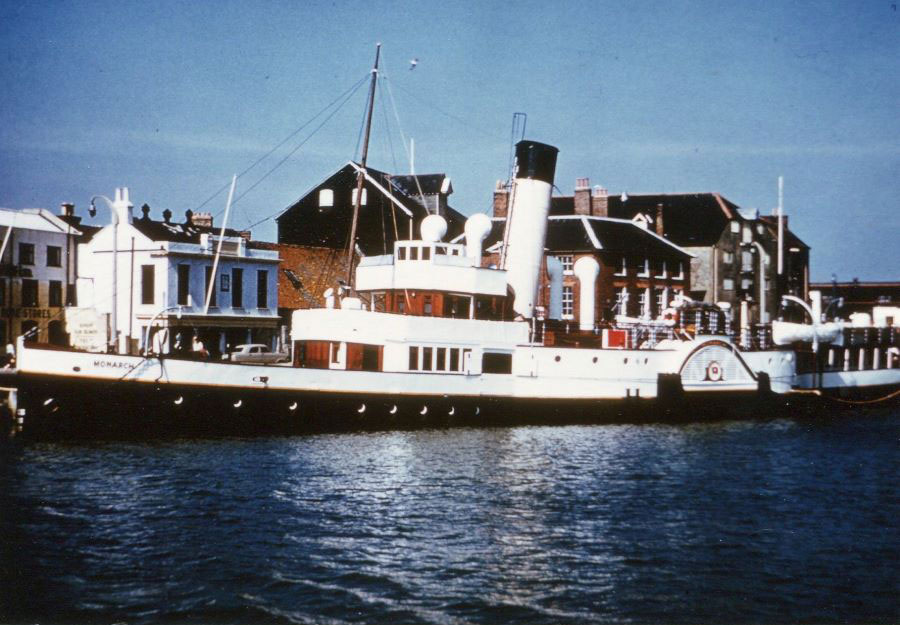
Where expansion had been the order of the day just after the war by the mid 1950s retrenchment had set in with the market for those wishing to go for a paddle steamer ride in steep decline. After the 1956 season Emperor of India was withdrawn and sold for scrap. Her master Captain Rawle transferred to Embassy so displacing Captain Haines who transferred back onto Monarch for the 1957, 58 and 59 seasons with Captain Defrates moving to Consul.
With a requirement for one less master, Captain Moore, who was senior to Captain Haines and had commanded Cosens’s paddle steamers before the war, left the company and in the doing of it bought the 50 passenger motor launch Topaz which he ran in subsequent years with his son Ken on trips round Portland Harbour from the Pleasure Pier. I remember walking past the Topaz often on my way down to join the Consul or in later years Princess Elizabeth and thought that Captain Moore brought a sort of shippy feel to such a small boat. For example he had a canvas dodger, just like on the paddle steamer bridges, set up around his steering position in the bow. And he had a sort of engine room telegraph system for controlling the engine with the use of signals by bell. Topaz was sold to Bob Wills in the early 1960s and he gave me some of my first paid work afloat in my youth..
It was during the winter of 1956/1957 that the great wooden deck houses were taken off Emperor of India, Embassy and Consul. They had been put on during the rebuilds of the ships after the war to enhance covered accommodation on deck and to provide a cover over the aft companionway. I have always wondered how great a part Captain Haines played in the decision to remove them.
He was the only Cosens captain to have sailed as permanent master of both Embassy and Monarch and so was uniquely positioned to judge the two ships relative handling capabilities. They were both designed for the railway connection between Portsmouth and Ryde and as built were pretty much identical ships of exactly the same dimensions. After the war Embassy’s rebuild had given her a much bigger and fatter funnel, a plated up aft saloon extending the full width of the ship and the massive deck house. That must have affected how she handled in any sort of wind at least to some extent.
Also unusually for a Cosens master Captain Haines was not averse to going round the decks helping the purser to sell tickets when the ship was really full leaving the mate in charge on the bridge. This would have given him an insight into the congestion that the deckhouse could cause amongst passengers, particularly on Embassy where the aft part of it didn’t leave much room for passengers to get by when the ship was full.
Did Captain Haines lobby to have the deckhouses removed? We know that he was outgoing and a good talker. For example at the retirement bash for General Manager Charles Kaille it was Captain Haines who made the speech on behalf of the captains and not the more senior Captain Rawle who, along with Captain Defrates, was also present.
Of course we will never know the answer to that I think. And in any case the removal of the deckhouses may have been down to the more prosaic cause of rot. A wooden structure sitting on a wooden deck can lead to the accumulation of damp seeping under the seals which starts to rot away both the bottom of the deckhouse and the deck itself. But whatever the case it is fascinating to ponder why it was done.
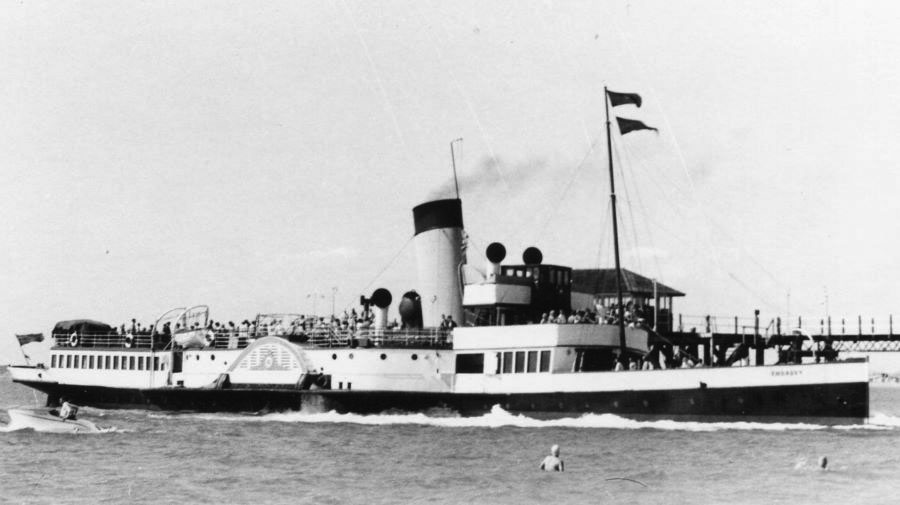
In 1959 Captain Rawle retired a few days before the end of the season with his place being taken on the bridge by Captain Haines who came back up to Poole to take command of Embassy the moment that he had laid up the Monarch in Weymouth. By that stage in Embassy’s career the bottom had dropped out of the market for long day trips so as well as running to Swanage, Embassy operated a clever schedule of a morning trip and afternoon trip from Bournemouth to either Totland Bay or Yarmouth with the morning trip also offering a day ashore or the opportunity to take a trip round the Isle of Wight by motor coach. This was a highly successful formula which led to Embassy often being full, or nearly full, on her peak week morning departures from Bournemouth.
With the writing now very much on the wall for the terminal decline of excursion paddle steamer trips Captain Haines left Cosens after the 1961 season to become a Poole Harbour pilot as Captain Cooke had done a decade earlier.
I did sail on Embassy when Captain Haines was her master but I never spoke to him or got to know him in the way that I did get to know Captain Defrates who was an affable sort of man ever keen to engage passengers in conversation. Of course different captains have different temperaments and different personalities and whilst all masters of passenger vessels should be welcoming to their passengers some have a better flair for this than others. Reports from the time say that Captain Haines was an excellent and highly competent master. However I have heard voices say that he could be a bit brusque. He was certainly no stranger to getting rid of crew members if they did not match up to his high standards. And that may have ruffled a few feathers in some quarters sometimes.
For example I recall one former employee of Cosens telling me that one particular ex crew member played a dirty trick on his old captain. Noticing that Captain Haines was aboard Embassy one day in her winter layup in the Weymouth Backwater down in her lower forward saloon tending the coke range which was set up in winter to keep the saloon warm, he quietly locked the saloon door at the top of the stairs with the captain still inside it and poured water down the range’s chimney on deck.
However this may very well say more about this man than it ever could about Captain Haines. And these sort of things did happen in those far gone days. For example I understand that it was not uncommon for more experienced hands to tie the boot laces together of apprentices sitting astride the tubes cleaning inside the boilers on paddle steamers so that they could neither reach down to untie them or get out. And this same source told me that on one occasion someone noticed Cosens’s General Manager Don Brooke’s car was sitting on the ramp at the Weymouth slipway so some wag leaned in and took the handbrake off.
Some of this was of course just silly jokes with no harmful intent. But for others maybe it was darker than that. Of course you may find disaffected people everywhere from time to time with their own story of unhappiness to unload on all who will listen but that is not necessarily a fair reflection of what is actually going on in the bigger story.
Look at the picture at the top of this little piece again and remember Captain Haines in congenial mood entertaining his passengers by cutting a cake to celebrate Embassy’s golden jubilee with a warm and cheery smile.
Kingswear Castle returned to service in 2023 after the first part of a major rebuild which is designed to set her up for the next 25 years running on the River Dart. The Paddle Steamer Kingswear Castle Trust is now fund raising for the second phase of the rebuild. You can read more about the rebuilds and how you can help if you can here.
John Megoran

